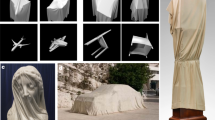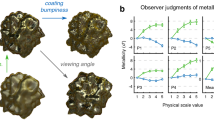Abstract
The human visual system can rapidly and accurately derive the three-dimensional orientation of surfaces by using variations in image intensity alone1–5.This ability to perceive shape from shading is one of the most important yet poorly understood aspects of human vision. Here we present several findings which may help reveal computational mechanisms underlying this ability. First, we find that perception of shape from shading is a global operation which assumes that there is only one light source illuminating the entire visual image. This implies that if two identical objects are viewed simultaneously and illuminated from different angles, then we would be able to perceive three-dimensional shape accurately in only one of them at a time. Second, three-dimensional shapes that are defined exclusively by shading can provide tokens for the perception of apparent motion, suggesting that the motion mechanism is remarkably versatile in the kinds of inputs it can use. Lastly, the occluding edges which delineate an object from its background can also powerfully influence the perception of three-dimensional shape from shading.
This is a preview of subscription content, access via your institution
Access options
Subscribe to this journal
Receive 51 print issues and online access
$199.00 per year
only $3.90 per issue
Buy this article
- Purchase on Springer Link
- Instant access to full article PDF
Prices may be subject to local taxes which are calculated during checkout
Similar content being viewed by others
References
Witkin, A. P. & Tenenbaum, J. M. in Human Machine Vision (eds Beck, J., Hope, B. & Rosenfeld, A.) 481–543 (Academic, New York, 1983).
Pentland, A. J. opt. Soc. Am. 72, 448–455 (1982).
Todd, J. & Mingolla, E. J. exp. Psychol. 9, 583–595 (1983).
Horn, B. K. P. in The Psychology of Computer Vision (ed. McGraw Hill, New York, 1975).
Yonas, A., Kuskowski, M. & Sternfels, S. Child Dev. 50, 495–500 (1979).
Ramachandran, V. S. & Anstis, S. M. Scient. Am. 254, 102–109 (1986).
Restle, F. in Organization and representation in perception (ed. Beck, J.) 31–36 (Lawrence Erlbaum, London, 1982).
Treisman, A. Scient. Am. 255, 114–126 (1986).
Julesz, B. Foundations of Cyclopean Perception (Chicago University Press, 1971).
Beck, J. Percept. Psychophys. 1, 300–302 (1966).
Albright, T. Soc. Neurosci. Abstr. 13, 1626 (1987).
Ramachandran, V. S., Rao, V. M. & Vidyasagar, T. R. Vision Res. 13, 1399–1401 (1973).
Gregory, R. L. Nature 238, 51–52 (1972).
Kanizsa, G. Scient. Am. 234, 48–52 (1976).
Ramachandran, V. S. Percept. Psychophys. 39, 361–373 (1986).
Ramachandran, V. S., Cobb, S. & Rogers-Ramachandran, D. Soc. Neurosci. Abstr. 13, 630 (1987).
Campbell, F. W. & Robson, J. G. J. Physiol., Lond. 197, 551–556 (1968).
Author information
Authors and Affiliations
Rights and permissions
About this article
Cite this article
Ramachandran, V. Perception of shape from shading. Nature 331, 163–166 (1988). https://doi.org/10.1038/331163a0
Received:
Accepted:
Published:
Issue Date:
DOI: https://doi.org/10.1038/331163a0
This article is cited by
-
The role of pictorial cues and contrast for camouflage
Evolutionary Ecology (2023)
-
Scanning laser ophthalmoscopy retroillumination: applications and illusions
International Journal of Retina and Vitreous (2022)
-
Recognizing why vision is inferential
Synthese (2022)
-
Lewis Carroll’s regress and the presuppositional structure of arguments
Linguistics and Philosophy (2022)
-
Early visual processing relevant to the reduction of adaptation-induced perceptual bias
Scientific Reports (2021)
Comments
By submitting a comment you agree to abide by our Terms and Community Guidelines. If you find something abusive or that does not comply with our terms or guidelines please flag it as inappropriate.



